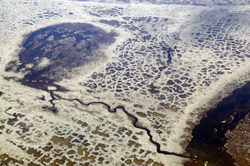Lab-0001
Permafrost Modeling - where does permafrost occur?
This lab is part of the series Permafrost. Others in this series are:
- Permafrost Modeling - where does permafrost occur? (1 of 4)
- Permafrost Modeling - the Active Layer (2 of 4)
- Permafrost Modeling - making maps from gridded climate data (3 of 4)
- Permafrost Modeling - looking at future permafrost with climate models (4 of 4)
Contributor(s)

What is permafrost and how do you make a first-order prediction about permafrost occurrence? This is lesson 1 in a mini-course on permafrost, this lab uses the Air Frost Number and annual temperature data to predict permafrost occurrence.
The Frost Number model is part of the Permamodel Toolbox, see Overeem et al. 2018.
Classroom organization
This lab is the first in a series of introduction to permafrost process modeling, designed for inexperienced users. In this first lesson, we explore the Air Frost Number model and learn to use such models in the CSDMS Python Model tool (Pymt). We implemented a basic configuration of the Air Frost Number (as formulated by Nelson and Outcalt in 1987). This lab is designed to gain some experience with running a numerical model, changing model inputs, and analyzing model output. Specifically, this first lab looks at what controls permafrost occurrence and compares the occurrence of permafrost in Russia.
Basic theory on the Air Frost Number is presented in File:FrostNumberModel Lecture1.pptx.
This lab will likely take ~ 1.5 hours to complete in the classroom. This time assumes you are unfamiliar with pymt and need to learn setting parameters, and looking at output (otherwise it will be much faster).
If you have never used the Python Modeling Tool (Pymt), learn how to use it at: https://pymt.readthedocs.io/en/latest. The Pymt allows you to set up simulations, and run them and then analyze data using Python.Download associated file: FrostNumberModel Lecture1.pptx
Presentation describes basic theory on the Air Frost Number
Skills
- Familiarize with a basic configuration of the Air Frost Number Model
- Make small changes to key input parameters
- See how to write a loop for calculations over a time series
- Hands-on experience with visualizing output in Python
- What is the primary control on the occurrence of permafrost
- Freezing and thawing day indices and how to approximate these
- Where in Russia permafrost occurs
- Critical evaluation of what the Air Frost number approximates
Lab notes
This lab can be run on the explore (for educators) and jupyter (for general use) instances of EarthscapeHub: just click one of the links under the Run online using heading at the top of this page, then run the notebook in the "PyMT" kernel.
If you don't already have an EarthscapeHub account, follow the instructions to sign up at https://csdms.colorado.edu/wiki/JupyterHub. If you're an educator, you can get EarthscapeHub accounts for you and your students--please contact us through the CSDMS Help Desk: https://csdms.github.io/help-desk.
Acknowledgements
These labs are developed with support from NSF Grant 1503559, ‘Towards a Tiered Permafrost Modeling Cyberinfrastructure’ and are part of the Permafrost Modeling Toolbox, https://github.com/permamodel.
References
- Nelson, F.E., Outcalt, S.I., 1987. A computational method for prediction and prediction and regionalization of permafrost. Arct. Alp. Res. 19, 279–288.
- Janke, J., Williams, M., Evans, A., 2012. A comparison of permafrost prediction models along a section of Trail Ridge Road, RMNP, CO. Geomorphology 138, 111-120.
- Overeem, Irina, Jafarov, Elchin, Wang, Kang, Schaefer, Kevin, Stewart, Scott, Clow, Gary, Piper, Mark, and Elshorbany, Yasin, 2018: A Modeling Toolbox for Permafrost Landscapes. Eos, Transactions of the American Geophysical Union (Online). https://doi.org/10.1029/2018EO105155.
